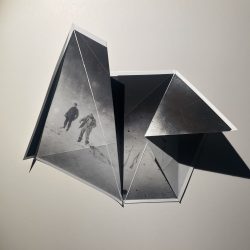The Helmer Transformations, a joint exhibition by Máté Dobokay and Áron Kútvölgyi-Szabó, is not only a juxtaposition of two artists, but also the result of a joint thinking and working process. The transformation in the title refers both to the source of the raw images and to the process of processing. The work of art, in both the figurative and the literal sense of the word, thus always revolves around some kind of transformation, whether medial or manual.
The starting point, the raw material for the collaborative work, is the work of the Swedish photographer, professor, writer and collector Helmer Bäckström (1891-1964), who was the first professor of photography at the Royal Swedish Institute of Technology: his digitised oeuvre forms the core material of two museums in Stockholm. The works of the two artists, which were expropriated and reworked, were the link and the starting point for this found collection.
The material, with its sometimes striking formal overlaps and visual analogies with their earlier works, provided an ideal platform for the collaborative work that preceded the exhibition. The images created through experimental processes, their medial transformations, were realised using photographic processes not previously employed, in which the concepts of re-creation and re-construction are reinterpreted according to themes: the relationship between image and space, the relationship between image and medium, image as object, image as space.
In Kútvölgyi-Szabó’s doctoral research, the role of imagery and spatiality in knowledge is presented, the image as a carrier of information, which, in parallel with representation, necessarily obscures, distorts or misinterprets certain information. With his folded, deformed works, he attempts to make images multi-view, a kind of spatialisation.
Dobokay’s works emphasise photography as a medium, as a malleable starting point, coloured by the themes of education and knowledge transfer. His experimental works are generally characterised by thinking about the structure of the photograph, and by pushing the boundaries of the medium.

